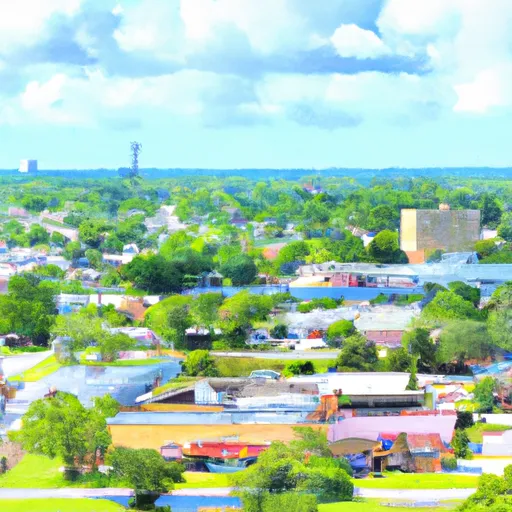-
 Snoflo Premium
Snoflo Premium
Get unlimited access to all our content
With no Ad interruptions! - Start Your Free Trial Login with existing account
Starke
Eden Index
Climate
7.7
•
Recreation
4.8
•
Community
2.0
•
Safeguard
5.3/10

Starke, Florida is a small city located in Bradford County, known for its moderate climate, diverse hydrology constituents, and numerous outdoor recreation opportunities. Situated in the northern part of the state, Starke experiences a subtropical climate, characterized by hot and humid summers, mild winters, and plenty of sunshine year-round. The average high temperature ranges from 65°F (18°C) in winter to 92°F (33°C) in summer.
The hydrology of Starke is influenced by its proximity to the Santa Fe River and other nearby lakes, including Lake Sampson and Lake Crosby. These water bodies offer opportunities for fishing, boating, and water sports. The Santa Fe River is particularly popular among kayakers and canoeists, thanks to its calm and scenic stretches.
Outdoor enthusiasts can also explore the numerous parks and nature trails in and around Starke, such as the Camp Blanding Wildlife Management Area, where activities like hiking, camping, and birdwatching are available. Additionally, the nearby Ocala National Forest offers opportunities for hiking, horseback riding, and hunting.
In summary, Starke, Florida boasts a pleasant climate, diverse hydrology constituents, and a range of outdoor recreational activities, making it an attractive destination for nature lovers and adventure seekers alike.
What is the Eden Index?
The Snoflo Eden Index serves as a comprehensive rating system for regions, evaluating their desirability through a holistic assessment of climate health, outdoor recreation opportunities, and natural disaster risk, acknowledging the profound impact of these factors on livability and well-being.
Climate Health Indicator (CHI): 7.7
Starke receives approximately
1308mm of rain per year,
with humidity levels near 89%
and air temperatures averaging around
20°C.
Starke has a plant hardyness factor of
9, meaning
plants and agriculture in this region tend to thrive here all year round.
By considering the ideal temperature range, reliable water supplies, clean air, and stable seasonal rain or snowpacks, the Climate Health Indicator (CHI) underscores the significance of a healthy climate as the foundation for quality living.
A healthy climate is paramount for ensuring a high quality of life and livability in a region, fostering both physical well-being and environmental harmony. This can be characterized by ideal temperatures, reliable access to water supplies, clean air, and consistent seasonal rain or snowpacks.
Weather Forecast
Streamflow Conditions
Suwannee
Area Rivers
Suwannee
Snowpack Depths
Suwannee
Reservoir Storage Capacity
Suwannee
Groundwater Levels
Recreational Opportunity Index (ROI): 4.8
The Recreational Opportunity Index (ROI) recognizes the value of outdoor recreational options, such as parks, hiking trails, camping sites, and fishing spots, while acknowledging that climate plays a pivotal role in ensuring the comfort and consistency of these experiences.
Access to outdoor recreational opportunities, encompassing activities such as parks, hiking, camping, and fishing, is crucial for overall well-being, and the climate plays a pivotal role in enabling and enhancing these experiences, ensuring that individuals can engage in nature-based activities comfortably and consistently.
Camping Areas
| Campground | Campsites | Reservations | Toilets | Showers | Elevation |
|---|---|---|---|---|---|
| Fore Lake | 100 | 82 ft | |||
| Santos Rec Area State Park | 24 | 74 ft | |||
| Lake Griffin State Rec Area | None | 85 ft | |||
| Ross Prairie | None | 54 ft | |||
| River Jct - Withlacoochee State Forest | 20 | 67 ft | |||
| Cypress Glen - Withlacoochee State Forest | 34 | 72 ft | |||
| Hog Island - Withlacoochee State Forest | 20 | 72 ft | |||
| Silver Lake - Withlacoochee State Forest | 23 | 78 ft | |||
| Gores Landing County Park | None | 31 ft | |||
| Crooked River - Withlacoochee State Forest | 26 | 72 ft |
Catastrophe Safeguard Index (CSI):
The Catastrophe Safeguard Index (CSI) recognizes that natural disaster risk, encompassing floods, fires, hurricanes, and tornadoes, can drastically affect safety and the overall appeal of an area.
The level of natural disaster risk in a region significantly affects safety and the overall livability, with climate change amplifying these risks by potentially increasing the frequency and intensity of events like floods, fires, hurricanes, and tornadoes, thereby posing substantial challenges to community resilience and well-being.
Community Resilience Indicator (CRI): 2.0
The Community Resilience Indicator (CRI) recognizes that education, healthcare, and socioeconomics are crucial to the well-being of a region. The CRI acknowledges the profound impact of these elements on residents' overall quality of life. By evaluating educational resources, healthcare accessibility, and economic inclusivity, the index captures the essential aspects that contribute to a thriving community, fostering resident satisfaction, equity, and social cohesion.

